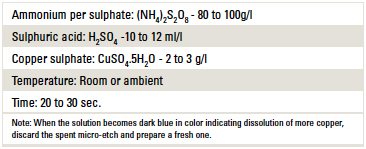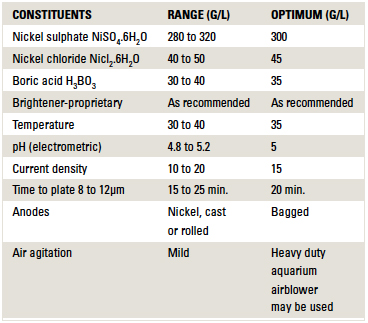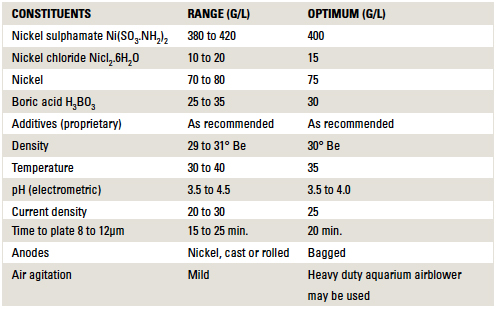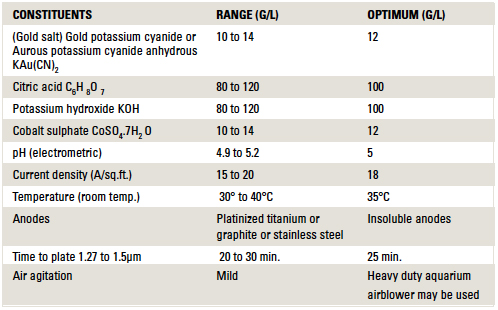Successful formulation, production and maintenance could provide years of reliable plating.
A common insertion type is PCB edge connectors or tabs to the female receptacle portion on the motherboard of equipment modules. Copper connectors or tabs on the PCB are plated with nickel (over copper) and then with gold, preferably AuCo or AuNi alloy, to achieve better abrasion resistance, wear resistance and corrosion resistance. Metals such as nickel or cobalt co-deposited in alloy gold usually serve as a brightener to increase the alloy gold deposit’s brightness.
Glass epoxy is used as the base material for PCB substrates, and the epoxy resin is sensitive and affected by alkali (pH >7 to 14) and alkaline solutions. Hence, gold is deposited from an acidic type of gold plating bath of pH less than 6.0 and generally between 4.0 and 5.5.
The thickness of gold is 1.25 to 1.5µm over nickel and copper, as detailed in TABLE 1. The etch-resist metal, tin or tin-lead alloy, on the connector is stripped in the metal stripper solution, scrub-cleaned and chemical-cleaned prior to the deposition of nickel and then gold over copper connectors.
Table 1. Connector Tab

In today’s pattern plating method, the etch-resist metal tin is stripped after etching and prior to solder masking with LPISM (liquid photoimageable solder mask) ink.
The portion above the connector is covered and protected by waterproof and chemical resistant polyester tape, such as 3M Circuit Plating Tape 851 or equivalent. The process sequence is below:
- Apply and paste waterproof, chemical-resistant and silicone adhesive polyester tape above the connector area to mask and protect the area above connectors/tabs.
- Strip tin on the tabs in tin stripper solution by dipping in it. Copper tabs are visible.
- Scrub clean using a smooth scrub pad (Scotch-Brite Ultra Fine Hand Pad 7448, 6" x 9") and rinse with water.
- Micro-etch by dip in 10% ammonium per sulphate (NH4)2S2O8 + 1% H2SO4 solution (TABLE 2) at room temp. (20 to 30 sec.).
- Swill thoroughly.
- Dip in 5 to 10% H2SO4 (2 to 3 min.).
- Swill thoroughly.
- Nickel plate in stress-free nickel sulphamate or semi-bright nickel bath (TABLE 3) to get 8 to 12µm for 20 to 25 min.
- Swill thoroughly.
- Gold plate in acid gold bath (TABLE 4) for 20 to 25 min. to get 1.25 to 1.5µm of gold. This bath is formulated to work at room temperature (25° to 40°C) to avoid evaporation loss. The rate of deposition is high at 40° to 45°C.
- Keep in drag-out solution (DI water).
- Swill in water.
- Dip in hot (about 50°C) DI water.
- Dry.
Table 2. Composition of Micro-etch Solution

Table 3. Nickel (Semi-Bright) Plating Bath Composition

Table 4. Nickel Sulphamate Bath Composition

Nickel sulphamate. Nickel sulphamate Ni (SO3.NH2)2 is available as a purified concentrate, and its composition and physical properties are below:
- Nickel sulphamate: 550 g/l
- Nickel (as metal): 100 g/l
- Specific gravity: 1.30 to 1.34
- Density: 33 to 35° Be
- Color: Green
Note: Optimum pH for low stress is at 4.0. Below 4.0 the stress increases slowly; at a pH of 5.0 it rises sharply. The higher the pH, the harder the deposit. Check boric acid by analysis and maintain its concentration around 30 to 35 g/l (TABLE 5).
Table 5. Acid Gold Plating Bath Composition

Procedure to mix 1000ml of gold plating solution. Take 500ml of DI water in a two liter capacity clean plastic or glass vessel. Dissolve 100g of potassium hydroxide by stirring. Being an exothermic reaction, the solution will become slightly hot. Slowly add 100g of citric acid granules and stir until it completely dissolves. Check the pH and adjust by adding drops of 10% w/v citric acid or 10% w/v KOH. When pH is 5.0, dissolve 12g of cobalt sulphate and increase the volume to 1000ml by adding DI water. At the end add 12g of gold potassium cyanide, stir well to mix thoroughly and transfer the solution to the plating tank.
Note: The freshly prepared solution is clear and pink in color. After plating tabs, the solution will slowly turn darker and culminate in a dark amber or brown color. The solution may be used for years without problems. Periodic addition of gold salt on the basis of area plated and additions of cobalt sulphate will keep the bath healthy. When more area is plated, gold content may be analyzed and gold salt added (see the procedure below). When the solution is not in use, it may be transferred to a clean plastic container with a lid for storage. When plating is necessary, transfer the stored solution to the plating tank, analyze for gold and cobalt content, and check pH. Add the required constituents of the bath; adjust pH by 10% w/v KOH or 10% citric acid and start.
Gold plating tank. An epoxy-reinforced PVC tray (size: 24" x 19") is used to gold plate three 24" x 18" (connector side) sized PCBs with tabs in 20mm depth solution and a volume of approx. 5.74-l. A heavy duty aquarium air blower may be used for air agitation during work.
A separate, similar size tank may be used for nickel plating.
Depending on the area plated, gold salt is added after one batch plated, every hour or per depletion of gold content of the bath to maintain optimum gold content, as insoluble anodes are used for this plating.
During production, analysis may be done at regular intervals of time (weekly basis or area of plating) to maintain the metal content at optimum conditions mentioned for the working bath.
When the solution is idle for a long time, it has to be analyzed and missing constituents added. Correct the pH to the working conditions and begin plating.

Figure 1. Plating tank made of fiber reinforced plastic material, with copper rods of 6 to 8 mm diameter used as anodes and cathodes.
Preparation of stock solution of cobalt sulphate (CoSO4.7H2O). Dissolve 12g of cobalt sulphate in 1000ml of DI water and keep ready. For every 1g of gold salt added, add 1ml of cobalt sulphate solution from the stock solution.
Properties of gold deposit:
a. Thickness: 1.25 to 1.5µm over 8 to 12µm of nickel. Thickness measured by ß-ray backscatter technique.
b. Alloy: Gold with cobalt. MHV (Micro Harness Vickers) Measured under microscope by indentation method.
c. Hardness: 120 to 150.
d. Number of insertions: 1000 numbers minimum (tested by physical insertion and removal in the module).
e. Peel test: By tape method per IPC-TM-650.
f. Surface appearance and properties: Per IPC-A-600.
Maintenance of Plating Solutions Chemical Analysis
1. Analysis of Nickel plating solution:
I. Total Nickel:
Reagents required:
a. Conc. Ammonia A.R.
b. Murexide indicator: Grind 0.2g of murexide A.R with 100g of sodium chloride A.R in a mortar to a fine powder and store in a clean glass or polyethylene bottle; label properly with contents and date.
c. 0.05M EDTA (C10H14N2Na2O8 ·2H2O, or disodium salt of ethylene diamine tetra acetic acid standard solution): Dissolve 10g of sodium hydroxide (NaOH) A.R. in 200ml of DI water placed in 1000ml volumetric flask. Weigh 18.6g of EDTA A.R. and record the exact weight. Transfer to the flask and stir to dissolve fully. Dilute to the mark with DI water, mix well and transfer to a clean polyethylene container. Label with molarity of EDTA with date.
M of EDTA = wt of EDTA / 372
Procedure:
- Pipette 2ml of plating solution in a 250ml capacity Erlenmeyer flask.
- Add 100ml of DI or distilled water.
- Add 10ml of conc. ammonia.
- Add 0.2g of Murexide indicator.
- Titrate with 0.05M EDTA standard solution by swirling the flask while adding the EDTA solution. Color change is from yellow to purple.
- Note the volume of EDTA consumed.
Calculation:
ml of EDTA solution x Molarity of EDTA x 29.35 = g/l of total nickel - “A”
Note: Atomic weight of Ni = 58.69
2. Nickel Chloride Nicl2.6H2O:
Reagents required:
a. 20% ammonium acetate (CH3COONH4): Dissolve 200 gms of ammonium acetate CH3COONH4, in 1000ml of DI water in a clean glass beaker, by stirring. Store it in a glass or polyethylene bottle; label it with contents and date.
b. Sodium chromate (Na2CrO4) indicator: Add 2.0 gms of Sodium chromate in 100ml of DI water and dissolve it fully by stirring. Transfer it and store in a clean polyethylene bottle, label with contents and date.
c. 0.1N silver nitrate (AgNO3) standard solutions: Take 700ml of distilled water in a 1000ml volumetric flask and add 5ml of Conc. HNO3. A.R. Add 17g of silver nitrate, stir well to dissolve completely. Dilute to the mark with distilled water after mixing well. Store in an amber color glass bottle; label with concentration and date. This has to be standardized with 0.1N potassium chloride (KCl), as below:
- Pipette out 25ml of 0.1N KCl into an Erlenmeyer flask.
- Add 25ml of DI water and 5ml of 20% ammonium acetate.
- Add 1ml of sodium chromate indicator.
- Titrate with silver nitrate with swirling until the precipitated silver chromate turns pink.
Normality of AgNO3 = ml of KCl X Normality of KCl /ml of AgNO3
Procedure for Nicl2.6H2O:
- Pipette 5ml of plating solution in a 250ml capacity Erlenmeyer flask.
- Add 100ml of DI or distilled water.
- Add 10ml of 20% ammonium acetate.
- Add 2ml of sodium chromate indicator solution.
- Titrate with 0.1N AgNO3 standard solution to a permanent faint pink end point, due to the formation of silver chromate (Ag2CrO4).
- Note the volume of 0.1N AgNO3 consumed.
Calculation:
ml AgNO3 x Normality of AgNO3 x 23.75 = g/l of Nicl2.6H2O – “B”
Note: Molecular weight of Nicl2.6H2O = 237.70; atomic weight of Ni = 58.69
3. Calculation of nickel sulphate (NiSO4.6H2O):
[(total nickel) – {0.247 x amount of nickel chloride Nicl2.6H2O)] x 4.48 = NiSO4.6H2O
[“A” – (0.247 x “B”)] x 4.48 = NiSO4. 6H2Og/l present in bath
Note: Molecular weight of Nicl2.6H2O = 262.85; atomic weight of Ni: 58.69
Factor = 262.85 / 58.69 = 4.48
4. Boric acid (H3BO3):
Reagents required:
a. Mannitol (C6H14O6 ) powder A.R.
b. Bromcresol purple indicator: (0.05% transition pH 5.2 yellow, pH 6.8 purple)
Add 2ml of 0.1N NaOH to 200ml of DI water and dissolve. Add 0.1g of Bromcresol purple A.R. Mix well and store in a glass or polyethylene bottle; label with concentration and date.
c. 0.1N NaOH: Add 4.0g of NaOH to a 1000ml volumetric flask and 100ml of boiled and cooled DI water, dissolve it and make it up to the mark with boiled and cooled DI water. Store in a glass or polyethylene bottle and label with normality and date.
Standardize NaOH as follows: Dry 50g of potassium acid phthalate A.R (KHP) at 110°C in oven for 2 hr. Cool in a desiccator and weigh 0.5g of KHP into a 250ml weighed Erlenmeyer flask and note the exact weight of KHP. Add 50ml of warm DI water and 2 to 3 drops of Phenolphthalein (dissolve 1g of Phenolphthalein in 100ml of isopropyl alcohol and store in glass dropper bottle) indicator. Titrate with NaOH to first pink end point.
N of NaOH = wt of KHP/ml of NaOH x 0.2042
Procedure:
- Pipette 2ml of plating solution in a 100ml capacity beaker.
- Add Mannitol powder to make a thick paste using a stirring rod to mix it.
- Add 0.5ml of bromcresol purple indicator.
- Titrate with 0.1N NaOH with stirring rod until mixture turns from yellow green to purple.
Calculation:
ml of NaOH x Normality of Na OH x 30.92 = g/l of H3BO3
Note: Molecular weight of H3BO3 = 61.84
Note: Add NiSO4. 6H2O, Nicl2.6H2O and H3BO3 per analysis and maintain the solution to optimum condition.
Hull cell test may be performed for the addition of brighteners or as suggested by supplier on amp-hour basis of use. When not in use, transfer the solution to a clean polyethylene container and close the lid to avoid evaporation loss.
II. Analysis of Nickel Sulphamate Bath:
- Total Nickel: Procedure as given in I.1
- Nickel chloride: Procedure as given in I.2
- Nickel sulphamate Ni(SO3.NH2)2:
Total nickel (0.247) x amount of nickel chloride x 4.27 = nickel sulphamate Ni (SO3.NH2)2
(“A” – 0.247) x “B” X 4.27 = Ni (SO3.NH2)2 g/l present in bath.
Note: a) Molecular weight of Ni (SO3.NH2)2 = 250.85; atomic weight of Ni: 58.69
Factor = 250.85 / 58.69 = 4.27
b) Nickel sulphamate concentrate contains 550g/l of Ni (SO3.NH2)2
ml of Ni (SO3.NH2)2 concentrate to be added per liter = g/l of Ni (SO3.NH2)2 x 1.82
4. Boric Acid: Procedure as given in I.4.
Hull cell test may be performed for the addition of brighteners or as suggested by supplier on amp-hour basis of use. When not in use, transfer the solution to a clean polyethylene container and keep to avoid evaporation loss.
III. Analysis of Gold Plating Solution
I. a. Gold Content (Gravimetric method):
a. 10% hydrogen peroxide (H202): Add 50ml of 30% H202 to 100ml of DI water in 250ml beaker, stir well using a glass rod. Store in a polyethylene bottle and keep the lid slightly loose to avoid possible explosion during storage. Label it with concentration and date.
- Take 10ml of plating solution in 100ml beaker and carefully add 10% H202 and bring to a boil to reduce gold metal.
- Continue boiling until till solution clears and gold sponge coagulates. If not clear, repeat H202 addition and repeat until it becomes clear solution.
- Cool and filter gold solution with gold sponge in a previously weighed (“A”) dry Gooch crucible with fiberglass filter. Wash with DI water and finally with methyl alcohol.
- Dry in oven at 110°C for 2 hr.
- Cool in desiccators and weigh it as “B.”
Calculation:
(“B’ – “A”) x 100 = g/l of gold (“C”)
“C” x 1.462 = g/l of K Au (CN)2
Note: Molecular weight of K Au (CN)2 = 288.33; Atomic weight of Au = 197.2
I. b. Gold Content (Volumetric method):
Reagents required:
a. Conc. Hcl A.R.
b. Potassium Iodide - KI Indicator: Add 20g of KI A.R. to 100ml of DI water in a 250ml beaker. Stir well with a glass rod to dissolve fully. Store in a glass or polyethylene bottle, label with concentration and date.
c. Starch indicator: Make slurry of 5g of starch A.R. with a small amount of cold water. Slowly add to 500ml of boiling water in 1000ml beaker and boil for 3 to 5 min. Cool and store in a glass or polyethylene bottle, label it with contents and date.
d. N/10 (0.1 N) Na2S2O3.5H2O Sodium thiosulphate standard solution: Dissolve 24.818g of Na2S2O3.5H2O in 700ml of boiled and cooled DI water in a 1000ml volumetric flask. Stir to dissolve fully and dilute with boiled and cooled DI water to the mark. Mix and transfer it to a glass or polyethylene bottle; label it with concentration and date.
Standardize the above solution with KIO3 Potassium iodate standard solution as follows:
- Pipette out 25ml of standard KIO3 solution in a 250ml Erlenmeyer flask.
- Add 30ml of DI water and 1g of KI and 10ml of 25% H2SO4.
- Titrate with swirling with the above Na2S2O3.5H2O solution; add 2ml of starch indicator until blue color disappears.
N of Na2S2O3.5H2O = ml of KIO3 x N of KIO3 /ml of Na2S2O3.5H2O
d. N/10 (0.1 N) Iodine solution: Dissolve 40g of KI in 100ml beaker. Weigh out 12.7g of I2 – iodine crystals and add to the KI solution and dissolve fully. Transfer to 1000ml of volumetric flask and dilute it to the mark and mix well. Transfer this solution to a dark color bottle properly labeled with normality of I2, concentration of I2 and date.
Standardize this above solution as follows:
Pipette out 25ml of standard As2O3 Arsenic trioxide solution in 250ml Erlenmeyer flask.
Add about 2g of NaHCO3 sodium bicarbonate, 50ml of DI water and 2 to 3 drops of 1% starch indicator to first blue end point, which remains for at least for 30 to 60 sec.
N of I2 = ml of As2O3 x N of As2O3 /ml of I2
Preparation of Standard As2O3 Arsenic trioxide solution:
Transfer 30g of As2O3 to a weighing bottle and dry in an oven at 110˚C for 2 hr. Cool it and keep. Dissolve 4g of KOH potassium hydroxide in 50ml of DI water in 250ml beaker. Weigh out 4.95g of As2O3 and record exact weight of As2O3. Transfer this to the KOH solution and stir to dissolve. Add 50% H2SO4 dropwise until just neutral to phenolphthalein and the solution is colorless. Cool, transfer to a 1000ml volumetric flask, and dilute with DI water to the mark. After mixing well, transfer it to a glass or polyethylene bottle properly labeled with normality of As2O3 concentration in g/l and date.
Normality of As2O3 = wt of As2O3 / 49.460
Procedure:
- Pipette out 10ml of plating solution in a 250ml flat bottom flask and add 15ml of conc. Hcl.
- Heat on a hot plate in a fume cupboard until the cyanide is destroyed. The solution becomes syrupy. Do not evaporate to dryness. This is to prevent and avoid difficulty in redissolving the salts.
- Cool and add 150ml of DI water; then 5g of KI (potassium iodide) dissolved in a minimum quantity of water.
- Add freshly prepared starch indicator and titrate with N/100 sodium thiosulphate (Na2S2O3) solution to a definite disappearance of the blue color.
- Now back titrate with N/100 iodine solution to the first permanent blue color of the iodide to starch.
Note: N/100 solutions are prepared by diluting N/10 solutions in a volumetric flask just before use, as they will not remain as concentrated solutions.
Calculation:
(ml of N/100 sodium thiosulphate – ml of N/100 iodine) x 0.09860 = g of gold in bath - (“A”)
“A” x 1.46 = g/l of K Au (CN)2
Note: 1ml of N/100 Sod.thiosulphate = 0.000985g of gold
Molecular weight of Na2S2O3.5H2O = 248.21; atomic weight of Au = 197.2
2. Cobalt content:
Reagents required:
a. Conc. ammonia:
b. Murexide indicator: Prepare as in total nickel analysis.
c. 0.05M EDTA standard solution: Prepare as in total nickel analysis.
Procedure:
- Pipette 2ml of plating solution in a 250ml capacity Erlenmeyer flask.
- Add 100ml of DI or distilled water.
- Add 10ml of conc. ammonia.
- Add 0.2g of Murexide indicator.
- Titrate with 0.05M EDTA standard solution with swirling the flask while adding the EDTA solution. Color change is from yellow to purple end point.
- Note the volume of EDTA consumed.
Calculation:
ml of EDTA x Molarity of EDTA x 29.47 = g/l of cobalt in the solution. (“A”)
Note: 281.11g of cobalt sulphate CoSO4.7H2O contains 58.94g of cobalt.
Amount of cobalt sulphate CoSO4.7H2O to be added = “A” x 4.77 g/l
General: The gold plating bath must be filtered through a thin muslin cloth to remove dust and other solid particles, if present. Due to continuous use, the solution may become thick and has to be diluted by DI water. A well maintained gold plating solution may be used for a very long period (five years or more) without problems.
References
1. Lawrence J. Durney, ed., Graham’s Electroplating Engineering Handbook, 4th Edition, CBS Publishers & Distributors, 1987.
2. Frank H. Reid and William Goldie, Gold Plating Technology, 3rd edition, Electrochemical Publications, June 1987.
Dr. Krishnaram Thoguluva Sesahdri is a plating and metal finishing consultant with wide experience in R&D, production and process control. He previously was chief executive (Techno-Commercial) at Meena Circuits Pvt. Ltd., and deputy general manager at Electronics Corp. of India Ltd.; This email address is being protected from spambots. You need JavaScript enabled to view it..
Register for PCB West, the Silicon Valley's largest printed circuit trade show, Sept. 15-17 at the Santa Clara Convention Center: pcbwest.com.



















